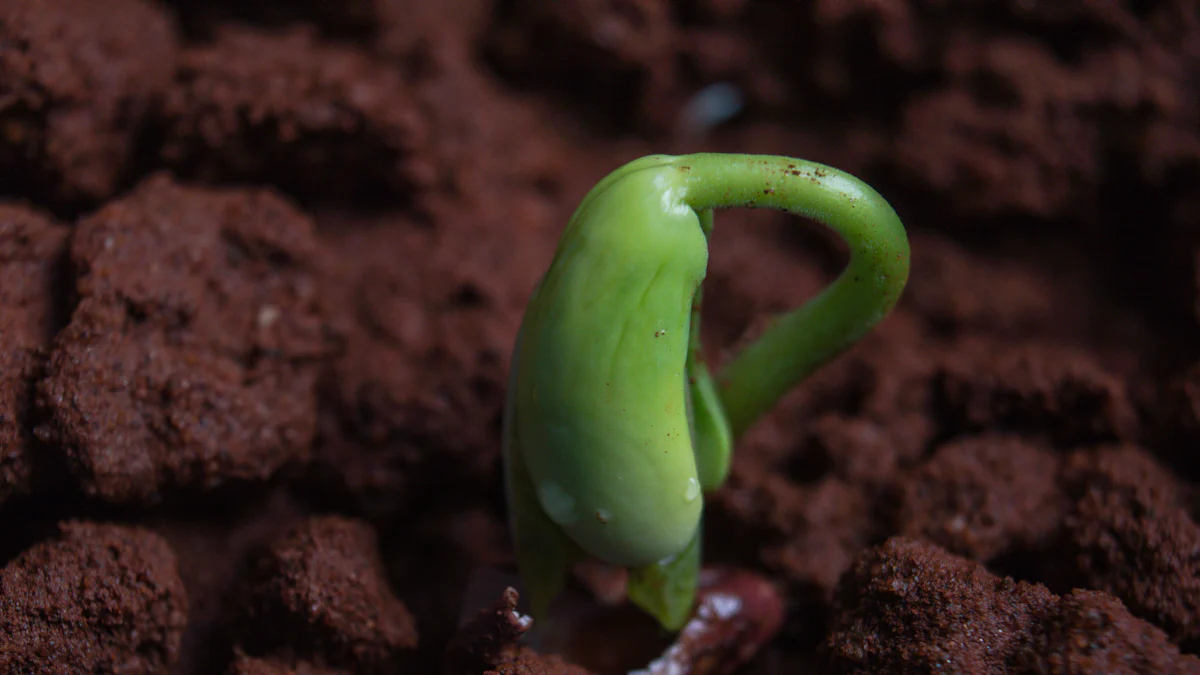How to Plant Comfrey Seeds: Tips for Successful Seed Propagation

Planting Comfrey Seeds
Are you considering growing comfrey from seeds? This comprehensive guide will equip you with valuable insights and techniques for successful seed propagation. Whether you're a novice gardener or an experienced enthusiast, mastering the art of growing comfrey from seeds can be a rewarding endeavor. From ideal growing conditions to essential care tips, this guide will provide you with the knowledge needed to cultivate thriving comfrey plants from seeds. So, let's delve into the fascinating world of comfrey seed propagation and unlock the secrets to nurturing these resilient plants.
Ideal Growing Conditions
When it comes to providing the perfect growth conditions for comfrey seeds, it's essential to understand the ideal growing conditions. Creating an optimal environment for comfrey plants ensures their successful establishment and robust growth.
Sunlight and Water
Comfrey thrives in areas with partial shade, making it well-suited for gardens and landscapes where sunlight may be filtered through trees or other foliage. Additionally, maintaining moist soil is crucial for the healthy development of comfrey plants. Adequate watering helps create a suitable environment for the seeds to germinate and the plants to flourish.
Temperature and Climate
Comfrey is known for its adaptability to various climates, but it tends to thrive best in temperate regions characterized by moderate temperatures. This resilient plant can withstand fluctuations in temperature, making it suitable for a wide range of environmental conditions.
Implementing these ideal growing conditions sets the stage for successful comfrey seed propagation and ensures the establishment of healthy, thriving plants.
Comfrey Plant Care
Pruning and Maintenance
When it comes to caring for comfrey plants, regular pruning and maintenance play a crucial role in ensuring their health and preventing overgrowth. Pruning comfrey involves cutting back the leaves and stems to manage its size and promote new growth. By removing old or damaged foliage, you can encourage the plant to focus its energy on producing fresh, vibrant leaves.
Tip: When pruning comfrey, it's important to use sharp gardening shears to make clean cuts without causing unnecessary damage to the plant.
Regular maintenance also involves keeping an eye out for any signs of disease or pest infestations. Promptly addressing these issues can prevent them from spreading and causing harm to the comfrey plants. Additionally, removing any debris or dead leaves from around the base of the plants helps maintain a clean growing environment and reduces the risk of fungal diseases.
Fertilization and Nutrient Needs
One of the remarkable characteristics of comfrey is its minimal need for fertilization. This resilient plant has a remarkable ability to accumulate essential nutrients, such as potassium, phosphorus, and calcium, from the soil. As comfrey grows, it draws these nutrients into its leaves, making it an excellent natural source of plant nutrition.
Adding organic matter around the base of comfrey plants can further enhance their nutrient uptake and overall health. Organic mulch not only enriches the soil but also helps retain moisture, creating an optimal growing environment for comfrey.
Incorporating these practices into your comfrey plant care routine will contribute to the well-being and vitality of your plants while minimizing the need for external fertilizers.

Seed Propagation Techniques
When it comes to propagating comfrey from seeds, employing the right techniques can significantly impact the success of germination and subsequent growth. Let's explore the essential seed preparation and planting methods for cultivating comfrey from seeds.
Seed Preparation
Properly preparing comfrey seeds before planting is a critical step in ensuring successful germination and robust growth. Start by scarifying the seeds, which involves gently scratching or nicking the seed coat to promote better water absorption and encourage germination. This process helps overcome the hard outer shell of the seeds, allowing moisture to penetrate more effectively.
After scarification, consider soaking the seeds in warm water for 12-24 hours. This pre-soaking method can further enhance germination rates by softening the seed coat and kickstarting the sprouting process. Once adequately prepped, the comfrey seeds are ready for planting, increasing their likelihood of successful establishment.
Planting Methods
There are several effective methods for planting comfrey seeds, each offering unique advantages depending on your gardening preferences and environmental conditions.
Direct Seeding
Direct seeding involves sowing comfrey seeds directly into prepared garden beds or outdoor growing areas. Choose a location with partial shade and moist soil, ensuring that the area receives adequate sunlight while maintaining consistent moisture levels. Gently press the prepared seeds into the soil at a depth of approximately 1/4 inch (0.6 cm) and cover them lightly with additional soil or compost. Water thoroughly after planting to provide optimal conditions for germination.

Starting Indoors
Starting comfrey seeds indoors allows for greater control over environmental variables such as temperature and moisture during the initial stages of growth. Begin by filling seedling trays or pots with well-draining potting mix. Sow the prepared comfrey seeds at a depth of about 1/4 inch (0.6 cm) and lightly cover them with soil. Place the trays in a warm, well-lit area, ensuring consistent moisture levels until seedlings emerge.
By employing these proven seed propagation techniques, you can increase your chances of successfully cultivating vibrant comfrey plants from seeds.
Soil Requirements for Comfrey
Comfrey, a resilient and versatile plant, thrives in specific soil conditions that promote its optimal growth and development. Understanding the soil requirements for comfrey is essential for cultivating healthy and vibrant plants.
Soil Type and pH
Comfrey favors well-draining, loamy soil that provides a balance of moisture retention and proper drainage. This type of soil structure allows the roots to access water while preventing waterlogging, which can lead to root rot and other issues. Additionally, comfrey exhibits optimal growth when the soil pH level falls within the range of 6.0 to 7.0. Maintaining this slightly acidic to neutral pH range creates an ideal environment for comfrey to flourish.
Soil Amendments
Enhancing the fertility of the soil by adding organic matter can significantly benefit the growth of comfrey plants. Organic amendments such as compost or well-rotted manure contribute essential nutrients to the soil, promoting robust plant growth and overall health. These organic materials also aid in improving soil structure, increasing microbial activity, and enhancing nutrient availability for comfrey plants.
By providing suitable soil conditions through proper type, pH level, and organic enrichment, you can create an environment that supports the successful cultivation of comfrey from seeds.
Tips for Successful Seed Propagation
Watering and Drainage
Proper watering and efficient drainage are fundamental factors in ensuring the successful propagation of comfrey seeds and the establishment of healthy plants. Consistency in providing adequate moisture without waterlogging the soil is crucial for supporting the germination and early growth stages of comfrey seeds. Here are some key tips for effective watering and drainage:
Watering Frequency: During the initial stages of seed germination, it's essential to keep the soil consistently moist but not overly saturated. Once the comfrey plants have established themselves, they generally require minimal additional watering due to their deep root systems. However, during prolonged dry spells, providing supplemental irrigation can help maintain plant vigor.
Mulching: Applying a layer of organic mulch around the base of comfrey plants can aid in moisture retention, reducing the frequency of watering while also contributing to weed suppression and soil insulation.
Drainage Considerations: Ensuring that the planting site has adequate drainage is critical for preventing water accumulation around the roots, which can lead to rot and other issues. If necessary, amending heavy or compacted soils with organic matter can improve drainage and create a more favorable growing environment for comfrey.
By paying close attention to watering practices and implementing suitable drainage measures, you can optimize the conditions for successful comfrey seed propagation and long-term plant health.
Pest and Disease Management
Implementing effective pest and disease management strategies is essential for safeguarding comfrey plants during seed propagation and throughout their growth cycle. While comfrey is known for its resilience against many pests and diseases, proactive measures can help mitigate potential issues:
Regular Monitoring: Vigilant observation of plant health is crucial for early detection of any signs of pest infestations or disease symptoms. Promptly addressing any abnormalities can prevent widespread damage.
Natural Predators: Encouraging natural predators such as ladybugs or lacewings can help control aphid populations that may affect comfrey plants. Additionally, practicing companion planting with insect-repelling herbs or flowers can deter pests from targeting comfrey.
Sanitation Practices: Maintaining cleanliness around the growing area by removing fallen leaves or debris can reduce potential habitats for pests and minimize disease spread.
By incorporating these pest management strategies into your approach to comfrey cultivation, you can promote a thriving growing environment while minimizing potential pest-related challenges.
Growing Thriving Comfrey from Seeds
Growing Thriving Comfrey from Seeds
Successfully cultivating thriving comfrey plants from seeds requires a combination of knowledge, care, and attention to detail. By following the recommended seed propagation techniques and providing the ideal growing conditions, you can set the stage for the robust growth and development of comfrey plants.
Here are some key considerations to ensure the successful cultivation of comfrey from seeds:
Patience and Observation: Cultivating comfrey from seeds demands patience as you observe the gradual process of germination and growth. Regularly monitoring the emerging seedlings and young plants allows you to identify any potential issues early on and take corrective measures.
Adaptability: Comfrey's adaptability to various environmental conditions makes it a resilient plant that can thrive in diverse settings. Whether you're tending to a garden, landscape, or container-grown plants, comfrey demonstrates remarkable adaptability when provided with suitable care.
Tip: Remember to provide adequate space for comfrey plants to spread as they mature, especially if you're growing multiple plants in a garden bed or outdoor area.
Sustainable Practices: Embracing sustainable gardening practices not only benefits the environment but also contributes to the long-term health of comfrey plants. Consider incorporating organic fertilizers, composting practices, and natural pest management methods to support a balanced ecosystem around your comfrey plants.
By integrating these considerations into your approach to growing comfrey from seeds, you can foster thriving and resilient plants that enrich your garden or landscape while contributing valuable ecological benefits. With dedication and an understanding of comfrey's unique characteristics, you can enjoy the rewards of successfully nurturing these versatile and beneficial plants.




Leave a comment